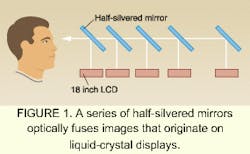THREE-DIMENSIONAL IMAGING: Stereoscopic display exploits the brain
Incorporating news from O plus E magazine, Tokyo
TOKYOResearchers at Nippon Telegraph and Telephone Corp. (NTT) have discovered a novel principle regarding three-dimensional (3-D) image perception and representation and have produced a trial stereoscopic display using this principle. Conventional stereoscopic 3-D image representation methods involve showing different images to the right and left eyes to create the illusion of depth. However, because the eye's focal point and the actual depth position do not match, these images cause eye fatigue. The NTT display does not cause such fatigue because the focal point corresponds to the depth position.
FIGURE 1. A series of half-silvered mirrors optically fuses images that originate on liquid-crystal displays.
The theory behind the new 3-D representation was discovered accidentally while investigating depth-sampling methods. Such sampling methods involve placing several image panels along the depth axis; the depth of each panel corresponds to the depth of the image that originates at that panel. The apparatus used for this experiment uses half-silvered mirrors to optically fuse images from multiple liquid-crystal-display panels (see Fig. 1). To eliminate the effects of attenuation, light levels are adjusted so that the proportion of light from each panel is the same when it reaches the eye.
With this method, the images on each of the panels are indeed located at the correct optical distance. The focal point can be adjusted to each image panel, so natural-seeming depth can be achieved. The problem, however, is that depth cannot be represented for objects located in between the image panels. To represent depth continuously, the number of image panels must be increased tremendously.
FIGURE 2. Brightness ratio of two overlapping images at different depths can be varied, changing the apparent depth of the fused image. If image plane 1 is made brighter, the image appears to be closer to image panel 1. If image plane 1 is made darker, the image seems closer to image plane 2. (This relationship holds true for the case of additive color mixing; for difference color mixing, the opposite holds.)
The NTT researchers' goal was to create a continuous depth image using standard optical materials, a small number of image panels, and no oscillation of the panels. They discovered that when the same image was represented on two panels, there appeared to be just one object, not two with one in front of the other.
This phenomenon is not trivial. Although the image on the rear panel is made slightly larger than the image on the front panel so that they overlap perfectly, it should not be possible to view the image so that they overlap perfectly, since objects at varying depths as viewed by both eyes are seen to have varying lateral shifts. Nevertheless, the image still appears to be just one object, the researchers discovered. The researchers presume that the effect arises from the way the brain processes the image.
While investigating the effect of changing the ratio of the brightness of the object represented on the two screens, the group discovered a simple relationship between the brightness ratio of the two images and the apparent depth position (see Fig. 2). As a result, a method of creating continuous depth images between two image panels has emerged. By using multiple panels, depth can be freely represented within a relatively wide depth range. By using five image panels, the group has been able to represent animated color images with continuous depth up to one meter.
The company is conducting this research as part of an initiative to develop high-realism image-transmission technologies. This new method requires only that standard 2-D images contain additional depth information per pixel in order to send 3-D images. The amount of data is only about 1.3 times as much as for standard 2-D images, so it is suited for transmission over networks.
Courtesy O plus E magazine, Tokyo

